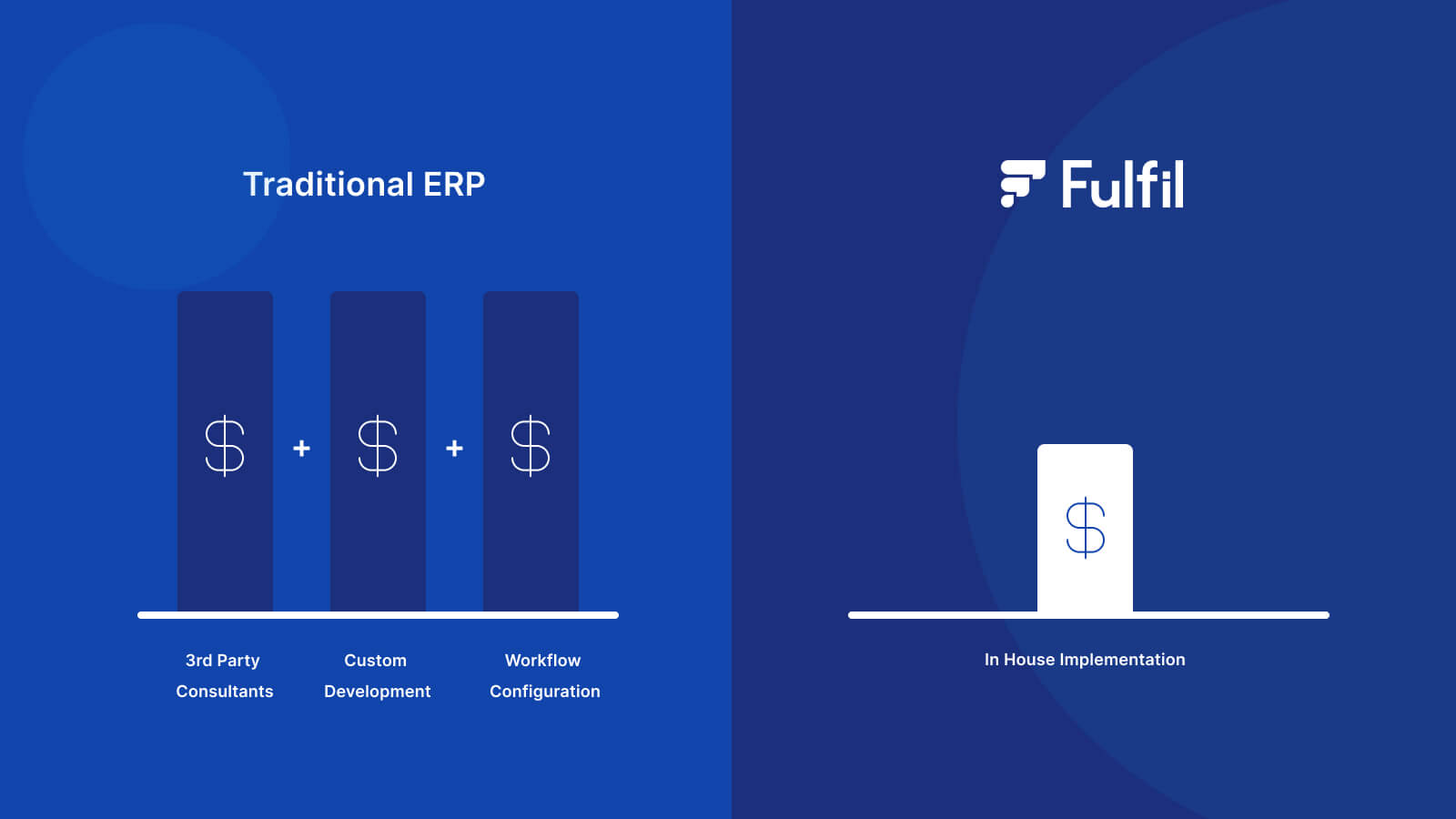Introduction
Implementing an ERP can unlock a new level of efficient growth for your company; you can use the same resources to accomplish more, by both increasing the productivity of each individual member of your team, and improving collaboration across teams. Once you’ve decided that an ERP is the right tool, it’s important to thoroughly evaluate which platform is the best fit for your company.
One of the key factors of this decision is understanding the Total Cost of Ownership over an extended period of time. Not all costs are immediately apparent during the evaluation process, and merchants will often find themselves surprised by ‘hidden costs’ after implementation of a traditional ERP. This article will help outline the different costs areas you should be considering during your evaluation process.
Implementation Costs
The first cost you can expect is a professional services fee for implementation. This can vary significantly depending on the platform, and the level of customization required to match your business needs.
For a Traditional ERP, extensive customization is typically required using third-party consultants. Traditional ERPs can be used for any type of business, from a gas station, to a restaurant, to a Fortune 500 company. Because it’s just a skeleton framework, it’s unlikely to meet your business needs “out of the box”, and you will likely need to invest a lot of time and money on customizations and development work..
With Fulfil, our platform has been designed from the ground up specifically for eCommerce merchants. This means that we have full support out of the box for common workflows like:
- Dropshipping
- Native integrations with all major sales channels
- Partially receiving supplier shipments
- Split order fulfillment from multiple warehouses
- + many more
Instead of complex, custom development which can take months and 10s of thousands of dollars, Fulfil can be configured within a fraction of the time and cost to support the majority of everyday eCommerce workflows.

Annual Recurring Costs
Any ERP that you onboard with will have an annual fee associated with using its platform. However, it’s important to read the fine print and understand exactly what your initial contract covers, and to understand how this will impact you as you scale.
Specifically, often Traditional ERPs will have unexpected scaling costs because of their order volume-based pricing model. Even if your “Basic Package” that you were initially quoted has a rock-bottom low price, it will likely include a volume-based stipulation that requires you to buy upgraded server space after a certain threshold, which can sometimes triple your original contract value.
In contrast, at Fulfil we pride ourselves on our transparent pricing model that is designed to scale with your company as you grow. For a bespoke quote, please complete our demo request form and our team will be happy to walk you through our process.
Integration Costs
Another area that can surprise unsuspecting business owners with additional costs is Integrations. Specifically, Traditional ERPs will often charge eCommerce brands for any additional sales channels, warehouses, carriers, and other integrations that you need to onboard.
This is because these legacy ERP platforms often do not have native integrations that can be used out of the box, and instead require a 3rd party and custom development work in order to effectively implement.
With Fulfil, we have native integrations to every major eCommerce sales channel, as well as 100s of other integrations to Carriers, 3PLs, marketplaces, banks, and more. This means that you won’t need an external team in order to be able to quickly stand up new integrations and get your data centralized into a single source of truth.

Ongoing Support/Maintenance
Any time you pay an external consultant to build a custom integration, or configuration for your ERP platform, it will likely also coincide with an ongoing maintenance fee. This is typically to ensure the integration stays active and functioning as desired.
Throughout this article we’ve discussed many different places where a Traditional ERP will require customization and development work, which naturally leads to much higher ongoing maintenance costs. These costs can sometimes exceed the initial sticker value of the ERP itself. Additionally, often Traditional ERPs will have a pay-per-use model for support, which can quickly add up if you have a growing team and go over your support ticket threshold.
In contrast, Fulfil is designed to be configured, not customized ,because the platform already has the necessary integrations and workflows that you’ll need to hit the ground running. And when you do need help, our in-house support team will be more than happy to answer as many questions that you and your team may have.
Conclusion
While the initial sticker price is important to look at during your ERP evaluation process, it’s important to consider the lifetime Total Cost of Ownership of an ERP. There are many potential hidden costs associated with implementing this type of software, and it therefore will pay dividends to evaluate this decision through the lens of a longer time horizon.
To learn more about Fulfil’s pricing model and implementation methodology, book a demo with our team.









